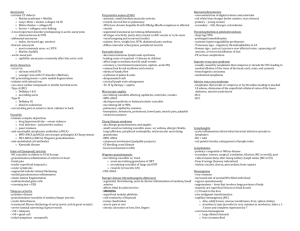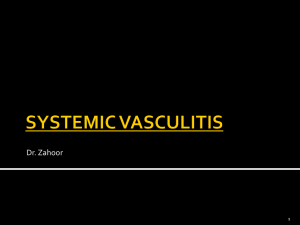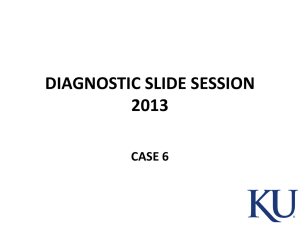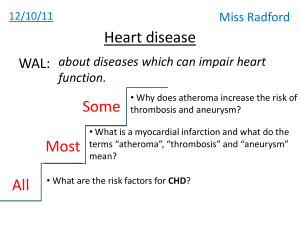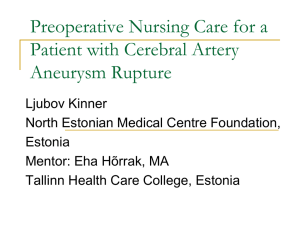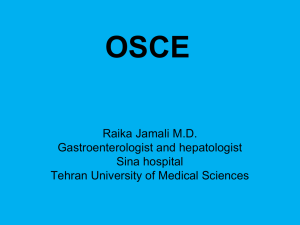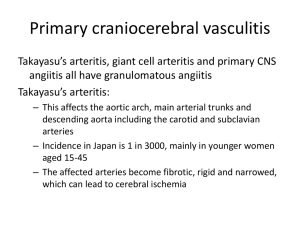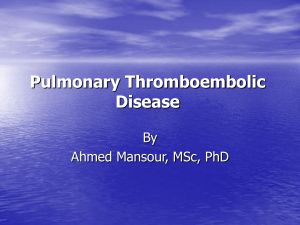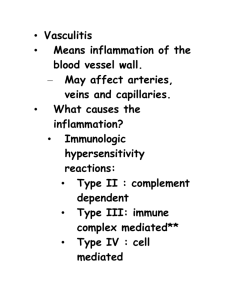CARDIOVASCULAR PATHOLOGY
advertisement
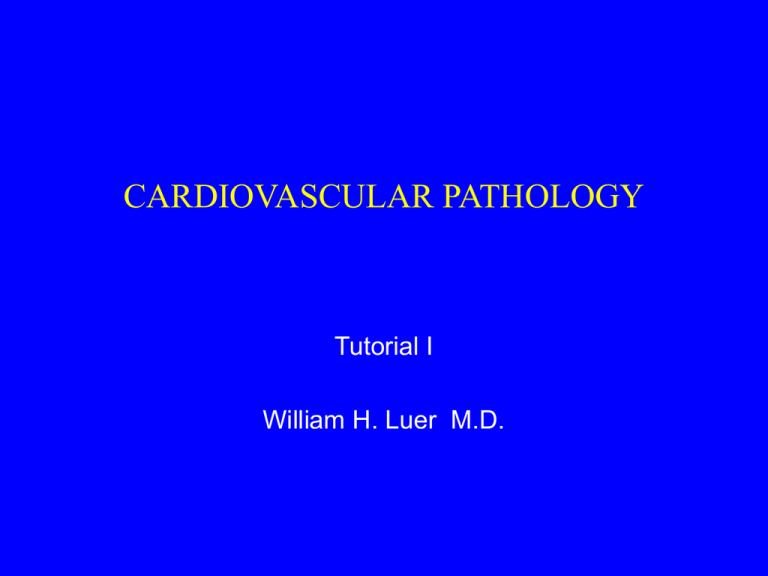
CARDIOVASCULAR PATHOLOGY Tutorial I William H. Luer M.D. TOPICS • • • • • Aneurysms Embolism Vasculitides Myocardial Infarction Diseases of Veins & Lymphatics ANEURYSM • An abnormal dilatation of an artery or vein • Caused by weakened vessel wall from: Congenital defect Systemic disease Atherosclerosis Infection Trauma SHAPES OF ANEURYSMS • • • • Saccular Fusiform Cylindroid Berry ATHEROSCLEROTIC ANEURYSM • • • • Atherosclerosis is the most common cause of aortic aneurysm Most frequently occur in males, >50 years of age Most occur in abdominal aorta, below the renal arteries Complications include thrombosis, embolism, and rupture Aorta Aneurysm with thrombus Kidney Kidney Atherosclerotic Abdominal Aortic Aneurysm SYPHILITIC ANEURYSM • Seen in tertiary stage of syphilis with obliterative endarteritis of vasa vasorum and aortitis • Roughening of intima: “Tree barking” • Involves the thoracic aorta • Complications include rupture, aortic insufficiency, and narrowing of coronary ostia Aortic Valve Aneurysm Syphilitic Aneurysm – Ascending Arch of Aorta MYCOTIC ANEURYSM • Bacterial infection weakens vessel wall • Associated with sepsis, bacterial endocarditis • May involve aorta or cerebral, renal, mesenteric, and splenic arteries BERRY ANEURYSM • • • • Involve cerebral arteries at bifurcations Probably arise at congenital points of weakness in wall Can rupture and result in subarachnoid hemorrhage Clinically may see headache, stiff neck (meningeal irritation) and death DISSECTING ANEURYSM • Entry of blood into substance of wall & extension along the length of the vessel • Actually a form of hematoma, hence also called dissecting hematoma • Male > female • Associated with hypertension DISSECTING ANEURYSM (CONT.) • Usually have tear in media where blood enters the wall & blood can reenter lumen through a second tear • Blood dissects in media as outer third & inner third of media separates • May be associated with cystic medial necrosis with loss of elastic and smooth muscle fibers • Can be seen in Marfan’s syndrome Dissection Aorta Aortic Valve Ascending Aorta – Dissecting Aneurysm PSEUDOANEURYSM • Injury to wall of vessel allows blood to escape from vessel into adjacent tissue • Extravasated blood coagulates and becomes a mass along side the vessel • This mass of blood (hematoma) gives the impression that there is an aneurysm Brachial artery Axillary fat Pseudoaneurysm with blood clot Axilla –Pseudoaneurysm, stab wound severed brachial artery EMBOLISM • The occlusion of a vessel by an object, the embolus, that has been transported to the site of occlusion, through the cardiovascular system. TYPES OF EMBOLI • • • • • • Thromboemboli Bone marrow emboli Fat emboli Air emboli Amniotic fluid emboli Foreign body emboli PULMONARY EMBOLISM (PE) • Cause of death in about 100,000 people per year in USA • Number 3 killer in USA, behind heart disease and cancer • Emboli travel to lungs and lodge in pulmonary arteries • Emboli usually from thrombi in deep veins of legs • Leg thrombosis common, found in 10-65% of autopsies on hospitalized patients VENOUS THROMBOSIS & PE ESPECIALLY COMMON IN: • • • • • • Prolonged bed rest Immobilization of extremity Congestive heart failure (CHF) Following trauma, burns, fractures, surgery During & after parturition Disseminated cancer PE • • • • PE often unsuspected Death may follow a large embolic event in seconds If not fatal, PE may or may not cause an infarct Consequences depend on size & number of emboli & the state of the circulation CASE OF FATAL PE • The following two photographs are from an autopsy performed on a 66 year old female who died suddenly on the second day after an open lung biopsy • She died as she was being moved from her bed (where she had been since surgery) to a chair • The cause of death was PE • The predisposing causes include surgery and immobilization during bed rest Coiled Embolus in Pulmonary Artery Pulmonary Emboli removed from Pulmonary Artery CASE OF PULMONARY INFARCT • Next photograph is from an elderly male in congestive heart failure • He experienced sudden pleuritic chest pain followed by hemoptysis Pulmonary infarct with hemorrhage Embolus Lung Lung – Pulmonary Infarct CASE OF RECURRENT PE • The next photograph is from an 86 year old male with chronic renal failure and bilateral deep vein thrombosis • He was experiencing recurrent pulmonary emboli • A filter was placed in the inferior vena cava to catch the emboli before they reached the lungs Greenfield Filter in Inferior Vena Cava with Trapped Emboli VASCULITIS • Inflammation & often necrosis of blood vessels • May be the predominant or sole manifestation of a disease or only on component of a disease • May induce tissue ischemia VASCULITIDES • • • • • • • • Polyarteritis nodosa Allergic granulomatosis of Churg & Strauss Kawasaki’s disease Hypersensitivity vasculitis Giant cell arteritis (Temporal arteritis) Takayasu’s arteritis Buerger’s disease Wegener’s granulomatosis POLYARTERITIS NODOSA (PN) • Systemic necrotizing vasculitis • Segmental involvement of small & medium sized muscular arteries • Often leads to microaneurysms • Widespread ischemic damage • Vascular lesions at different stages of evolution • Probably due to immunologic disorder since see Ig & C in lesions & about 30% of cases have Hepatitis B antigenemia and have + p-ANCA: perinuclear antineutrophil cytoplasmic antibodies PN CLINICAL • Male > Female • Erratic multisystem involvement, may see tender muscles, skin lesions, subcutaneous nodules, malaise, fever, weight loss, high blood pressure, hematuria, abdominal pain, diarrhea, melena • May be acute or chronic with recurrences • Renal involvement may be prominent & often cause of death with hematuria, albuminuria, and hypertension • Treat with immunosuppression ALLERGIC GRANULOMATOSIS OF CHURG &STAUSS • Vascular lesions resemble PN but involve vessels in lung (in contrast to PN) • Related to allergy, esp. asthma • See peripheral eosinophilia & eosinophils in vascular lesions • Probably a hypersensitivity disorder KAWASAKI’S DISEASE • Most have heart involvement • See necrotizing vasculitis of coronary arteries (lesions resemble PN) • May see thrombosis, aneurysm, and myocardial infarction • Possible viral etiology HYPERSENSITIVITY VASCULITIS (HV) • Involves post-capillary venules, mostly in skin to produce palpable purpura, can affect internal organs and tissues • Mediated by immune complex deposition, Type III hypersensitivity • Causes include drugs: penicillin, sulfonamides bacterial: beta hemolytic Streptococcus endogenous antigen Hepatitis B antigen HV: PATHOLOGY • Leukocytoclastic vasculitis, features are: fibrinoid necrosis of vascular wall extravasation of red blood cells nuclear dust from PMN breakdown • Vascular lesions all about same stage • Can resolve, recur, or become chronic GIANT CELL ARTERITIS (GCA) • Also called temporal arteritis • Female>Male, usually >50 years of age • Typically involves temporal artery, but may involve other medium to large sized arteries, but rarely renal (in contrast to PN) • Possible autoimmune reaction to elastic fibers in vessel wall GCA: PATHOLOGY • Full thickness granulomatous inflammation of vessel wall • Destruction of elastic lamina • Thrombosis & fibrosis • Can have “skip areas” in affected vessel, where inflammation is lacking GCA: CLINICAL • Weakness, malaise, fever, weight loss, headache • Can become chronic, usually resolves • Can affect sight if involves ocular vessels TAKAYASU’S ARTERITIS • Female>Male, young • Decreased pulses in upper extremities, ischemia of upper body • Etiology unknown • Adventitial inflammation, that moves inward to involve full thickness of vessel, may see thrombosis & scarring • Aortic arch may show irregular thickening and stenosis BUERGER’S DISEASE • Also called thromboangitis obliterans • Related to cigarette smoking, 25-50 year olds • Involves radial & tibial arteries and adjacent nerves and veins • See thrombosis, organization, recanalization, microabscess, granulomas, & fibrosis of vascular bundle • In extremities get pain, ischemia, ulcers, & gangrene WEGENER’S GRANULOMATOSIS • Necrotizing vasculitis, esp. in lung, kidney, and spleen • Acute necrotizing granulomatous lesions in lung, and in nasal & oral cavities • Proliferative glomerulonephritis • See cytoplasmic diffuse antineutrophil cytoplasmic antibody (c-ANCA) • 90% remission with cytotoxic treatment “NAME THAT VASCULITIS” • Test your vasculitis knowledge • The next slide will give a characteristic(s) of one of the vasculitides • Name the vasculitis from the information given • The slide after will name the vasculitis • Good Luck CHARACTERISTIC • Affects post capillary venules in skin producing a palpable purpura ANSWER • Hypersensitivity (Leukocytoclastic) Vasculitis CHARACTERISTIC • Facial pain, headache, fever, fatigue, weight loss, in an elderly female ANSWER • Giant Cell (Temporal) Arteritis CHARACTERISTIC • • • • Gastrointestinal bleeding Renal failure Fever + p-ANCA (perinuclear antineutrophil cytoplasmic antibody) • Vessel biopsy: transmural necrotizing acute inflammation of vessel wall ANSWER • Polyarteritis Nodosa CHARACTERISTICS • • • • Necrotizing granulomas in respiratory tract Necrotizing granulomatous vasculitis in lungs Necrotizing cresentric glomerulonephritis + c-ANCA (cytoplasmic diffuse anti-neutrophil cytoplasmic antibody) ANSWER • Wegener’s Granulomatosis MYOCARDIAL INFARCTION • Topic covered in lecture • Case study discussed in tutorial DISEASES OF VEINS • Varicose Veins • Thrombophlebitis VARICOSE VEINS • Legs: associated with pregnancy, increasing age, and can be familial • Hemorrhoids: associated with pregnancy and cirrhosis • Esophageal varices: associated with cirrhosis COMPLICATIONS OF VARICSOSE VEINS • • • • Pain Stasis Thrombosis Bleeding THROMBOPHLEBITIS • • • • Deep vein thrombosis, usually in lower extremities Pain Risk of pulmonary embolism Associated with: congestive heart failure, prolonged bed rest, post operative & post partal states, trauma, & neoplasm (esp. pancreatic cancer-Trousseau’s sign) Diseases of Lymphatics • Lymphangitis – inflamed lymphatics • Secondary Lymphedema from inflammatory scarring, metastatic carcinoma, surgical resection (eg. arm edema post mastectomy), radiation therapy induced fibrosis, & filariasis CARDIOVASCULAR PATHOLOGY Tutorial I The End
